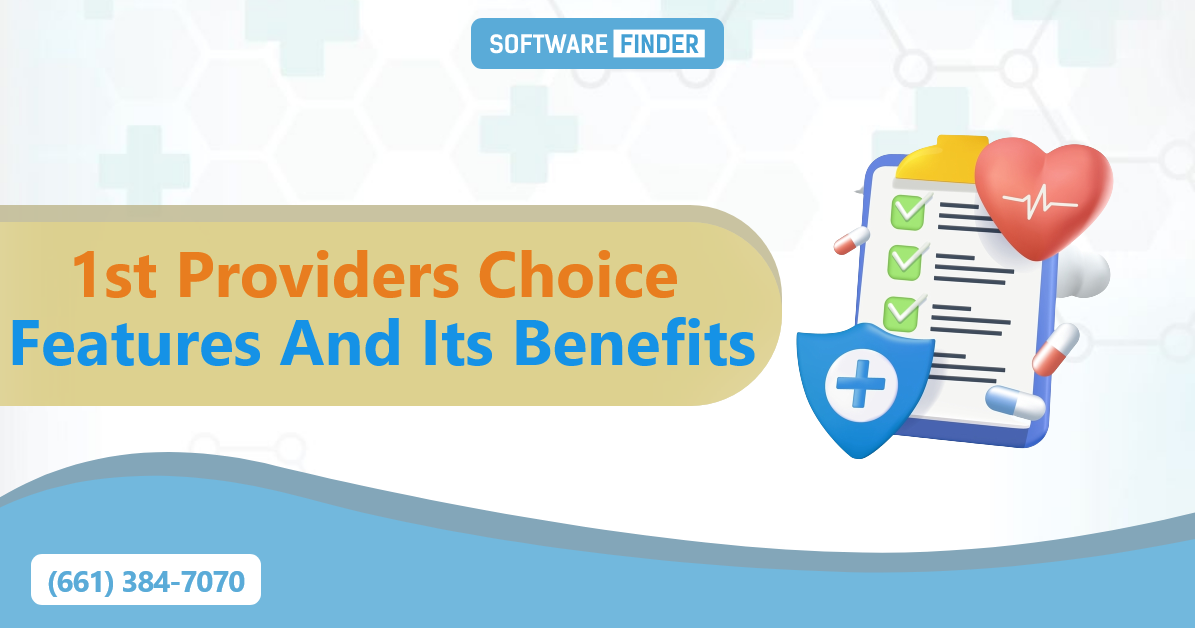First Providers Choice EMR provides web-based access to medical professionals with complete patient records, progress notes, as well as dynamic care changes. The First Providers Choice EMR features include improved documentation accuracy, coding help, multiple record creation and HIPAA-compliant communication. You can use it as either a web-based solution or a server-based one.
American EHR Partners rated 1st Providers’ Choice the No.1 EMR.
1st Providers’ Choice is a Cloud-based EHR system and practice management software that can be used by any size practice. It’s easy to use and supports healthcare professionals across more than 30 specialties. All users can access US-based support from the US.
It was created in 1989 and is used by thousands of doctors across the U.S. Concept Processing is an artificial intelligence technology that allows the software to self-learn while the user can chart in free text. American EHR Partners ranked it the #1 EHR and it has won numerous awards. It can also be used for the CMS Quality Reporting Programs and MACRA.
1st Providers Choice’s software provides a comprehensive healthcare management system that ensures top-quality service. It streamlines check-in and checkout processes, improving patient experience as well as physician-patient interaction. It allows users to create patient billing information, and then post charges faster than ever before. It offers a range of services and tools that allow physicians to run their practice more efficiently.
Research is key to choosing the right EHR system for your practice. Compare the features, pricing, customer service, and support before you make a decision on an EHR system. To get an idea of the interface, ask for a demo. Ask about hidden fees or add-on charges.
1st Providers Choice, a web-based EMR system for health care professionals, is designed specifically for them. Its integrated billing features and exercise tracking make it a great solution for multidisciplinary clinics. It can handle many patient types and has several useful features such as the ability create charts with a stylus.
It is HIPAA compliant
Protecting patient information is paramount, regardless of whether it’s a medical practice and an electronic health record. Protected healthcare data (PHI), which can be both electronic and physical, includes demographics, health history, mental and lab results, as well as insurance information. It also contains personally identifiable information such as your name and social security number. This information is protected by a HIPAA compliant EHR system.
HIPAA compliance is crucial for the protection of electronic medical information. EMRs must comply with a variety of technical requirements. These requirements can be found in the Technical Safeguards of the Security Rule of HIPAA. We’ll be reviewing seven key components of HIPAA compliance in electronic medical records.
Individuals must give authorization in advance to cover entities so that PHI is kept private. A covered entity can charge a fee to access PHI if they don’t have prior authorization. These companies should also be transparent about the fees they charge for their services.
An individual may be charged a fee by a covered entity to copy PHI. However, the fee must be disclosed in advance. Individuals may also request PHI from the covered entity. The covered entity must also provide access to the designated records sets.
HIPAA restricts the disclosure of medical information without authorization. There are exceptions to this rule. In some states, for example, the patient must consent to the release of their medical records to a third-party. These regulations allow medical information to be shared with other health care providers to receive treatment or payment. The practice may also use the information to perform health care operations, such as quality assessment, performance review and training.
HIPAA protects personal health information. The Act protects the patient’s right to access their health information. This Act outlines the rights of patients to access their health information and requires that covered entities comply with these rights.
Read Also: dr first emr
It provides a portal for patients
Patient portals are a great way for patients and doctors to communicate with one another. They can book appointments, refill prescriptions and track compliance. Patients can upload documents and practice forms to make it easier for them to access. It makes it easier for doctors to share information with their patients.
1st Providers’ Choice is a trusted and affordable EHR software. This cloud-based software for medical practices includes more than 30 specialty-specific templates. It offers many practice management features, including appointment scheduling, workflow management, lab integration, and clinical workflow management. The 1st Providers’ Choice EMR provides a patient portal that allows you to manage the patient experience.
Patient portals can also be used to improve patient engagement and encourage patient-centered care. Patients can access their medical records anywhere they are. Doctors can also communicate with patients via email. It can be used by doctors to maintain an online relationship. This will result in higher patient satisfaction as well as better retention of patients.
A patient portal can streamline your office’s workflow, and improve coordination between your medical team. Everyone on your team can concentrate on improving patient outcomes by having a portal. The medical staff will have to constantly relay information to their doctors without one. This could be inconsistent or inaccurate. A patient portal saves time and allows patients to electronically submit information, which results in fewer errors in patient records.
An EMR system can have a patient portal that is a valuable addition. This portal can increase patient engagement by encouraging patients to take part in their healthcare and schedule appointments with their doctors. Patients portals allow patients to access their medical records from any location. Providers also have an easy-to use interface through patient portals.
1st Providers Choice’s EMR for healthcare dermatology is one of its best features. It has a patient portal. Patients can update their personal information online and complete any required forms prior to their visit. They can also save time and reduce paperwork, which will help them avoid repeat visits.
It is more expensive than the industry average
The first question people ask about EMRs is “How much does First Providers Choice cost?” It isn’t expensive, and it is comparable to the industry average. It is important to remember that the price does not include hardware, training, or customization. It does not include a trial period.
Costs associated with the system will also depend on features and integrations. A vanilla EMR might be sufficient to get you started. However, you will need additional features to make your system more useful. Many vendors charge extra fees for this. These extra features include integrated practice management and medical billing software. These extra features require additional hardware, such as fax machines and printers.
A cloud-based EMR also has the advantage of predictable costs. Cloud-based software is always up-to-date, unlike traditional EMRs that are installed on premises. Cloud-based software requires a broadband connection because it uses the Internet. It is a good choice for small to medium-sized practices due to its low initial cost.
An EMR system costs much less than a paper-chart-based one. It allows you to record all of your patients’ information at once, which decreases the need for multiple medical records or clerical assistance.
Hospitals might also be concerned about the high costs of implementing an EMR. The capital investment required to implement an EMR is one of the greatest challenges. A five-year study concluded that the EMR investment was both financially profitable and positive for cash flow. The implementation process can be slow.
I am a professional writer and blogger. I’m researching and writing about innovation, Entertainment, technology, business, and the latest digital marketing trends click here to go website. Follow my blog here & Visit my website here.



